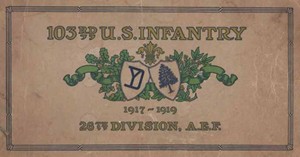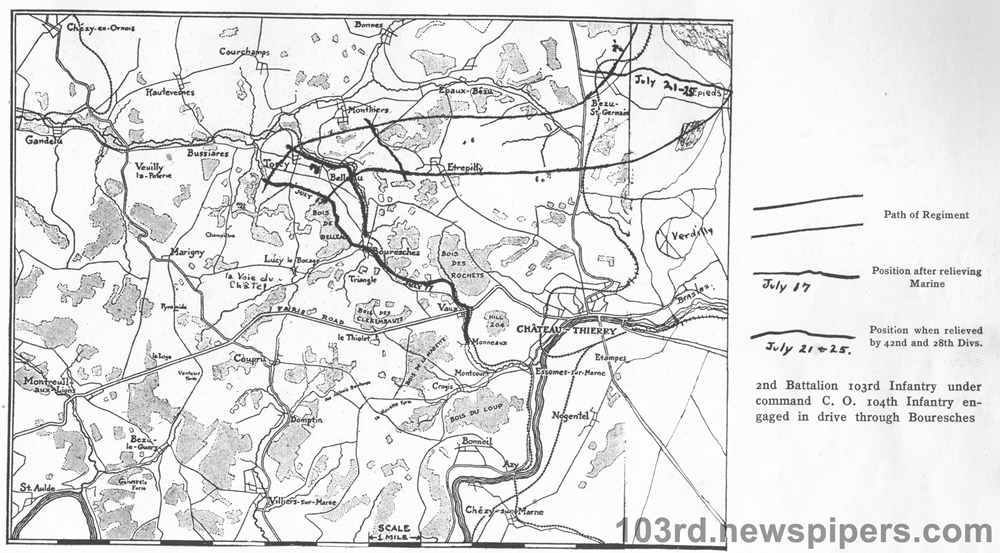
of the 26th Division of the U.S. Army
during World War I
 | The History of the 103rd Regiment of the 26th Division of the U.S. Army during World War I |
| Table of Contents | ||
 personally relieved the 3rd Battalion and ordered it to join the rest of the Regi-
ment. The movement of the lst amd 2nd Buttzilions was begun iiiinicdiotely and
before morning the entire regiment was assembled in the Bois de Chzmte Merle.
On the morning of 24th July_1918, orders were received from the 52nd Brigade
to follow the 104th Infantry m an advanced march to Truguy by way of Lu
Seererie Fine, Trugny Road. This march was to be in column of squads with
zimmuuition trains following each Battalion and the Brigade Train follow in rear
of the 103rd Infantry. Upon arriving in field noillicust of Ln Sacrerle Fine.
column was halted, kitchens brmight up, men fed mid the regiment di.reete1 to
meirch to the woods near Souilhird `Frirm, as the regiment had been relieved.
This was done and at 20:00 cfulock ell elements of the regiment were assembled
as ordered.
Losses for the regiment were heavy. 5 0{Iicers were killed, 32 wounded. 155
men were killed, 940 wounded. Many of these eesuzxlties were caused by gas
which was used on several occasions by the enemy. In every imsmnue, beth offi-
cers and men conducted themselves like veterans. Too much praise cannot be
given to our supporting and attached troops. The 5lst Artilleiy Brigade, 103rd
Machine-Gun Battalion, 101st M.G. Battalion, 103rml M.G. C0., detachmcnis
from the 102nd and 104th Field Ambulance Cos. and demehments from the 101st
Signal Battalion were in 21 great wziy instrumental to our success. The Y. M. C.
shelters were in several instances used as dressing stations and their seeretiwies
in connection with Imth of our own Chophiius worked incessantly in bringing m
wounded and generally cheering up the troops.
Such ci report as the above dues not give the human side of sur=h,en oiiensive,
nor an idea of the natural dihiculties to be overcome along with all the rest.
Reference by name in conjunction with thc map shows iu :1 general way how far
this regiinrut went; its casualties show what that cost, The spirit of the men
was remarkable. I rcrmll the remarks of Lieutenant ]*`1·iend of the British Army
who was iibourd the Lapland: “\’V:1it until you’ve bled si bit, then you'll know
your men" ; and it luis proven true not only at Chfitezm-Tliieiwy, but in the later
offensives. Huis off to the mzui with ride uu his shoulder, for if cvrr the Amer-
iezm Im":mh‘yma11 proved himself, it was iu that week of July 18 to July 24.
There were numerous iiismmces of bravery mid of endurance. Non commis-
sioned oilicers showed their worth and initiative, time and again taking com-
mand of their platoons and czu·1·yiug on. Mem took all kinds of chances, and
gladly, for the word mime down that the drive must be carried on to the lust
ounce. Therein the A1ueri=an spirit showed itself.
In comzluding this chapter on our first offensive I wish to quote again from
the article before referred to, for the remarks summarize briefly this division’s
part and what was true of the division applied 1.0 this regiment.
"The Yankee Division held the sector northeast of Clieteeiu-'1‘liierry between
Bussiamres and Vaux, on the rend from Chhteuu-Tliierry to Ln Fei·tl:~s0us-Joumre,
having on its right mul left two French divisions. On the 18th nf July, at thirty-
five minutes past four in the morning, they attacked with vigor, although some-
what handicapped boumise their left wing was far behind the right, lmd therefore
forced to advance very rapidly iu order to straighten their line. The village of
Torcy was carried in on hour, the Germans being taken quite by surprise; Bellcemu
zmd Givry were occupied, and thc railway reached. The lighting in Givry was
very grim. Hill 193, which was to have been taken by the French on the Ameri-
can left, held out, amd the Americans were thus exposed to a. heavy enhlamding
fire, from which they lost heavily. At hist this hill was eerried, thanks to the
help of the Amerieeus, amd the forward push went on; the villages of Epieds and
Trugny were taken by storm, zmcl the division reached the road from Jaulgonne
te Fere—eu-Tardeneis, In six days it had advanced zi distance of 17 kilometers,
taken 248 prisoners, a heavy 210-mm. cannon und many mnehine guns, thus de-
serving, as did all other American divisions, the splendid praise given them by
Foch when he received the representatives of the Allied press. ‘As to the Ameri-
cans,’ he said, ‘yeu may say that they are admirable soldiers; I have only one
fault to [ind with them - they want to go forward too fast- I ain obliged to
hold them back. They want to push on ull the time and kill as many Germans
as they possibly cen}
"When these gallant American divisions received their baptism of fire, fighting
magnifieently beside the wai·-hardened French troops, n decisive moment in the
wer had been reached. The eomradeship, the brotherhood between the French
and the Americans w:».~; strengthened upon the field of bzittle, and their blood,
shed side by side for the same cause, senled forever the union of these two great
mitiuns."
HEADQUARTERS 2(ith DIVISION
American Expeditionary Forces
I·`nrxz~:cn Aucvsir 2, 1918.
Grzxrznu. Ommns No. 67.
To the Ojiccra and Ellen of the 26th Division:
On July 18th you entered, as part of the Allied drive ngxiinst the enemy, upon
thc offensive, und continued the offensive oomlmt until the major portion of the
command was relieved on July 25th,
personally relieved the 3rd Battalion and ordered it to join the rest of the Regi-
ment. The movement of the lst amd 2nd Buttzilions was begun iiiinicdiotely and
before morning the entire regiment was assembled in the Bois de Chzmte Merle.
On the morning of 24th July_1918, orders were received from the 52nd Brigade
to follow the 104th Infantry m an advanced march to Truguy by way of Lu
Seererie Fine, Trugny Road. This march was to be in column of squads with
zimmuuition trains following each Battalion and the Brigade Train follow in rear
of the 103rd Infantry. Upon arriving in field noillicust of Ln Sacrerle Fine.
column was halted, kitchens brmight up, men fed mid the regiment di.reete1 to
meirch to the woods near Souilhird `Frirm, as the regiment had been relieved.
This was done and at 20:00 cfulock ell elements of the regiment were assembled
as ordered.
Losses for the regiment were heavy. 5 0{Iicers were killed, 32 wounded. 155
men were killed, 940 wounded. Many of these eesuzxlties were caused by gas
which was used on several occasions by the enemy. In every imsmnue, beth offi-
cers and men conducted themselves like veterans. Too much praise cannot be
given to our supporting and attached troops. The 5lst Artilleiy Brigade, 103rd
Machine-Gun Battalion, 101st M.G. Battalion, 103rml M.G. C0., detachmcnis
from the 102nd and 104th Field Ambulance Cos. and demehments from the 101st
Signal Battalion were in 21 great wziy instrumental to our success. The Y. M. C.
shelters were in several instances used as dressing stations and their seeretiwies
in connection with Imth of our own Chophiius worked incessantly in bringing m
wounded and generally cheering up the troops.
Such ci report as the above dues not give the human side of sur=h,en oiiensive,
nor an idea of the natural dihiculties to be overcome along with all the rest.
Reference by name in conjunction with thc map shows iu :1 general way how far
this regiinrut went; its casualties show what that cost, The spirit of the men
was remarkable. I rcrmll the remarks of Lieutenant ]*`1·iend of the British Army
who was iibourd the Lapland: “\’V:1it until you’ve bled si bit, then you'll know
your men" ; and it luis proven true not only at Chfitezm-Tliieiwy, but in the later
offensives. Huis off to the mzui with ride uu his shoulder, for if cvrr the Amer-
iezm Im":mh‘yma11 proved himself, it was iu that week of July 18 to July 24.
There were numerous iiismmces of bravery mid of endurance. Non commis-
sioned oilicers showed their worth and initiative, time and again taking com-
mand of their platoons and czu·1·yiug on. Mem took all kinds of chances, and
gladly, for the word mime down that the drive must be carried on to the lust
ounce. Therein the A1ueri=an spirit showed itself.
In comzluding this chapter on our first offensive I wish to quote again from
the article before referred to, for the remarks summarize briefly this division’s
part and what was true of the division applied 1.0 this regiment.
"The Yankee Division held the sector northeast of Clieteeiu-'1‘liierry between
Bussiamres and Vaux, on the rend from Chhteuu-Tliierry to Ln Fei·tl:~s0us-Joumre,
having on its right mul left two French divisions. On the 18th nf July, at thirty-
five minutes past four in the morning, they attacked with vigor, although some-
what handicapped boumise their left wing was far behind the right, lmd therefore
forced to advance very rapidly iu order to straighten their line. The village of
Torcy was carried in on hour, the Germans being taken quite by surprise; Bellcemu
zmd Givry were occupied, and thc railway reached. The lighting in Givry was
very grim. Hill 193, which was to have been taken by the French on the Ameri-
can left, held out, amd the Americans were thus exposed to a. heavy enhlamding
fire, from which they lost heavily. At hist this hill was eerried, thanks to the
help of the Amerieeus, amd the forward push went on; the villages of Epieds and
Trugny were taken by storm, zmcl the division reached the road from Jaulgonne
te Fere—eu-Tardeneis, In six days it had advanced zi distance of 17 kilometers,
taken 248 prisoners, a heavy 210-mm. cannon und many mnehine guns, thus de-
serving, as did all other American divisions, the splendid praise given them by
Foch when he received the representatives of the Allied press. ‘As to the Ameri-
cans,’ he said, ‘yeu may say that they are admirable soldiers; I have only one
fault to [ind with them - they want to go forward too fast- I ain obliged to
hold them back. They want to push on ull the time and kill as many Germans
as they possibly cen}
"When these gallant American divisions received their baptism of fire, fighting
magnifieently beside the wai·-hardened French troops, n decisive moment in the
wer had been reached. The eomradeship, the brotherhood between the French
and the Americans w:».~; strengthened upon the field of bzittle, and their blood,
shed side by side for the same cause, senled forever the union of these two great
mitiuns."
HEADQUARTERS 2(ith DIVISION
American Expeditionary Forces
I·`nrxz~:cn Aucvsir 2, 1918.
Grzxrznu. Ommns No. 67.
To the Ojiccra and Ellen of the 26th Division:
On July 18th you entered, as part of the Allied drive ngxiinst the enemy, upon
thc offensive, und continued the offensive oomlmt until the major portion of the
command was relieved on July 25th,
|
||
| Original Version of Page |